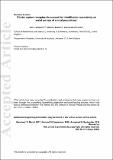Files in this item
Cluster capture-recapture to account for identification uncertainty on aerial surveys of animal populations
Item metadata
| dc.contributor.author | Stevenson, Ben C. | |
| dc.contributor.author | Borchers, David L. | |
| dc.contributor.author | Fewster, Rachel M. | |
| dc.date.accessioned | 2020-04-01T23:31:51Z | |
| dc.date.available | 2020-04-01T23:31:51Z | |
| dc.date.issued | 2019 | |
| dc.identifier | 255284445 | |
| dc.identifier | f11adcc5-d9ec-43fe-87b7-fbb6874fe5fa | |
| dc.identifier | 000471347100030 | |
| dc.identifier | 85063807572 | |
| dc.identifier | 000471347100030 | |
| dc.identifier.citation | Stevenson , B C , Borchers , D L & Fewster , R M 2019 , ' Cluster capture-recapture to account for identification uncertainty on aerial surveys of animal populations ' , Biometrics , vol. 75 , no. 1 , pp. 326-336 . https://doi.org/10.1111/biom.12983 | en |
| dc.identifier.issn | 0006-341X | |
| dc.identifier.other | ORCID: /0000-0002-3944-0754/work/72842425 | |
| dc.identifier.uri | https://hdl.handle.net/10023/19741 | |
| dc.description | This work was funded by a joint EPSRC/NERC PhD grant (No. EP/1000917/1), by the EPSRC through a Doctoral Prize Fellowship, and by the Royal Society of New Zealand through Marsden grant 14-UOA-155. | en |
| dc.description.abstract | Capture‐recapture methods for estimating wildlife population sizes almost always require their users to identify every detected animal. Many modern‐day wildlife surveys detect animals without physical capture—visual detection by cameras is one such example. However, for every pair of detections, the surveyor faces a decision that is often fraught with uncertainty: are they linked to the same individual? An inability to resolve every such decision to a high degree of certainty prevents the use of standard capture‐recapture methods, impeding the estimation of animal density. Here, we develop an estimator for aerial surveys, on which two planes or unmanned vehicles (drones) fly a transect over the survey region, detecting individuals via high‐definition cameras. Identities remain unknown, so one cannot discern if two detections match to the same animal; however, detections in close proximity are more likely to match. By modeling detection locations as a clustered point process, we extend recently developed methodology and propose a precise and computationally efficient estimator of animal density that does not require individual identification. We illustrate the method with an aerial survey of porpoise, on which cameras detect individuals at the surface of the sea, and we need to take account of the fact that they are not always at the surface. | |
| dc.format.extent | 11 | |
| dc.format.extent | 1319001 | |
| dc.language.iso | eng | |
| dc.relation.ispartof | Biometrics | en |
| dc.subject | Capture-recapture | en |
| dc.subject | Neyman-scott process | en |
| dc.subject | Palm intensity | en |
| dc.subject | Spatial capture-recapture | en |
| dc.subject | Thomas process | en |
| dc.subject | Unmanned aerial vehicles | en |
| dc.subject | QA Mathematics | en |
| dc.subject | QH301 Biology | en |
| dc.subject | DAS | en |
| dc.subject.lcc | QA | en |
| dc.subject.lcc | QH301 | en |
| dc.title | Cluster capture-recapture to account for identification uncertainty on aerial surveys of animal populations | en |
| dc.type | Journal article | en |
| dc.contributor.institution | University of St Andrews. Pure Mathematics | en |
| dc.contributor.institution | University of St Andrews. Statistics | en |
| dc.contributor.institution | University of St Andrews. Marine Alliance for Science & Technology Scotland | en |
| dc.contributor.institution | University of St Andrews. Scottish Oceans Institute | en |
| dc.contributor.institution | University of St Andrews. Centre for Research into Ecological & Environmental Modelling | en |
| dc.identifier.doi | https://doi.org/10.1111/biom.12983 | |
| dc.description.status | Peer reviewed | en |
| dc.date.embargoedUntil | 2020-04-02 |
This item appears in the following Collection(s)
Items in the St Andrews Research Repository are protected by copyright, with all rights reserved, unless otherwise indicated.

